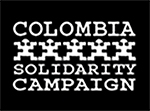When travelling in Colombia, the effects of US foreign policy are not easily ignored: impoverished slums on the outskirts of cities, families with economic difficulties, paramilitary atrocities, miles and miles of rainforest destroyed by ever growing US fumigation programs, etc etc.
There is one aspect of US imperialist activities in Colombia, though, that goes greatly unnoticed. Nevertheless, this weapon, one of the most powerful in the imperialist arsenal, is found at work in most households and public gathering places, and most people are oblivious of its profoundly negative effects on them and may even defend it if it came under critisicism. It is called cultural imperialism.
Cultural imperialism manipulates and westernises the psychology of people in Third World countries, aligning them with US imperialist interests. It is incredibly effective because it dominates people from the inside, disguised as their own free will. Cultural imperialism’s role is to control the psyche of third world inhabitants, creating a politically submissive populace and awakening a consumerist desire in people so that fertile markets for western commodities can be cultivated.
Cultural imperialism is strongly targeted at young people who are the perfect audience, socially sensitive and easily adaptable to change. The youth of Colombia also pose a significant threat to the Colombian authorities. Everyone knows that rebelliousness is innate in adolescents. This volatile force is agitated by the oppression and suffering that much of Colombia’s youth is subjected to, so it is crucial for US interests that it is not allowed to be channelled into any constructive protests or campaigns. Instead this rebellion is directed by cultural imperialism into alcohol, drugs, parties, consumerism and aspiring to a western lifestyle. There is a growing club scene in Colombia, and ‘designer’ drugs that are manufactured in the US and Europe are increasing rapidly in popularity. When I was in Bogotá, I saw many teenagers wearing baggy trousers, flat soled skate shoes and carrying skateboards. I would have thought they were North American had I not seen their Colombian faces. As in our country, most youths believe they are rebellious, but they are really just playing into the hands of their enemies and strengthening their own weaknesses.
During my trip to Colombia I visited an indigenous community in the Amazonian jungle of Caqueta in southern Colombia. The elder of the community, a 102-year-old shaman, told me about how the old customs and ancient wisdom of his ancestors has reached its final generation and will soon be lost. This particular village, like so many others in Colombia is crumbling and losing its indigenous culture. The young people, I was told by the shaman, are only interested in drinking and the novelty of adopting a western lifestyle. He told me that the community used to be happy, and function well when it was still based on indigenous ethics. In many of the houses in this village I saw posters advertising cigarettes, US beers and Coca-Cola.
The indigenous of Colombia are some of the hardest hit by cultural imperialism. The South American indigenous culture strikes a hard contrast to western culture. Therefore, in the eyes of the US, it must be destroyed and devalued. Cultural Imperialism has made people all over South America turn against their own cultural roots and being indigenous is now generally looked on as old fashioned and inferior. The indigenous population of Colombia face discrimination and racism, and this of course brings them social insecurity, making the temptation of westernisation even stronger. The indigenous people represent a strong force of opposition to the US campaign of South American subordination. By attacking these people, cultural imperialism is fragmenting them, weakening them and destroying their natural solidarity.
It is sad, but on an increasing scale what was once the community living and working together harmoniously is now the town in which people go about their business without a sense of belonging or solidarity.
The most formidable tool for cultural imperialism is the mass media, noticeably the beloved television set. On many of the long bus journeys I took in Colombia, there were TVs on the buses. What struck me was that in all of the adverts blond-haired, blued-eyed North American men, women and children were modelling the products. Another scandalous thing was that the screen was often dominated by the vacuous ‘entertainment’ of the miss Colombia contest.
Between the years 1980 and 1990 the number of TV sets per person in Latin America increased by 40%. In the same period, the average income for Latin Americans decreased by 40% and the peoples’ struggle against US imperialism decreased significantly. These figures speak for themselves.
Television catches the Colombian population in a vicious circle that can only be called addictive torture. It offers many Colombians an escape into fantasy from their situation of suffering that is created in the first place by the imperialist West. It is seductive, presenting a false solution to suffering, sowing dreams of happiness and ‘success’ that will never be realised and tying people up in the world of consumerism that only brings more suffering.
People sit hypnotised by glamorous TV stars, Colombians who have ‘made it’, who, according to the values of imperialism, are superior to their audience, taking away the dignity of real men, women and children.
In Colombia, as all over the world, the mass media helps to convert good words into vehicles for lies. According to the rhetoric of cultural imperialism, tyrants are left wing liberal politicians, democracy is a system that serves the rich minority, liberty means complete US domination and mass slaughter and bombing sessions are called peace. While the Colombian public is desensitised to government atrocities, a guerrilla kidnapping is a terrible crime of huge proportions and the words FARC and ELN are despised and feared by many. Anyone against the authorities is categorised, dehumanised and named a terrorist, making the killing of innocent campesinos acceptable. What is more, video games and high-budget Hollywood films glorify this so-called righteous violence.
It is now a fashion in Colombia for women to die their hair blond, showing that North Americans are the respectable symbols of aspiration. The disillusioned public are being trained to be more individualistic and selfish and therefore weak, easy victims of the US divide and conquer strategy.
Cultural imperialism is the counterpart to Plan Colombia. It is psychological warfare. Its goal is to turn the Colombian people into a mass of hypnotised robots who will not question or fight against US dictates.
I do not want to give the impression that all Colombians are robots. The people of Latin America are some of the most revolutionary people in the world. There are many people in Colombia who are working ceaselessly for real change.
Ultimately, we must all realise the perpetual cycle of suffering that our western culture creates and rebel against it. In solidarity we can work together with our Colombian brothers to resist cultural imperialism and break these chains of slavery. There is hope.
Peter Woodman

